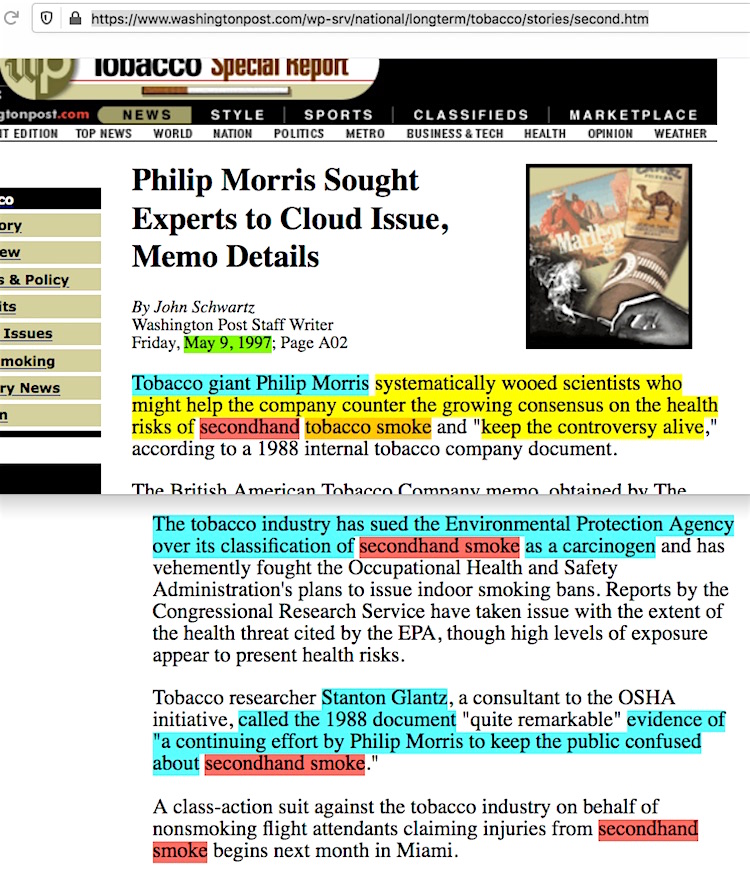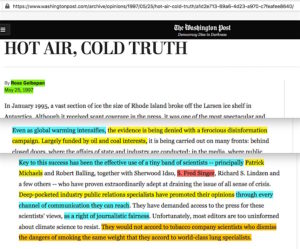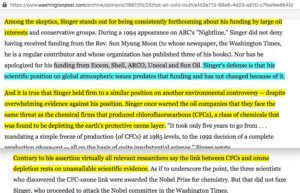The “tobacco angle” being the notion that the fossil fuel industry allegedly fully knows their products cause catastrophic global warming harm in a manner no different that the tobacco industry knowing full well about the cancer-causing harm of cigarette smoking, and how both industries are accused of creating disinformation campaigns to deceive the public about the harm of their products. Within the global warming disinformation accusation is the claim that some of the same people supposedly spewing climate disinformation also did so for the tobacco industry. “Merchants of Doubt” book author / documentary movie star Naomi Oreskes gained heroic – no, make that “supernova” / “living legend” – status from revealing this claim to the world, partly praised on that latter accolade by no less than the person she credits with being the first to steer her toward that ‘tobacco industry connection,’ Lawrence Livermore atmospheric scientist Ben Santer.
Examine Oreskes’ particular narrative about …
1) being personally attacked after she wrote a paper about the scientific consensus for man-caused global warming; 2) advised to talk to Ben Santer, a victim of a similar attack; and 3) how Santer “started telling this whole story about how he had been attacked by Fred Seitz and how it was just like the tobacco industry…”
…. at a superficial level, and sounds quite plausible. Go deeper on that last bit, and various problems start to arise.
“… it was just like the tobacco industry…”
What’s that supposed to mean?
At least Oreskes answers that question in the opening pages of her “Merchants of Doubt” with the following passage on page five after a setup on the previous pages about Santer being ‘attacked’ by “a group of physicists tied to a think tank in Washington, DC,” specifically an ‘attack’ via a single June 12, 1996 Wall Street Journal op-ed.
A few years later, Santer was reading the morning paper and came across an article describing how some scientists had participated in a program, organized by the tobacco industry, to discredit scientific evidence linking tobacco to cancer. The idea, the article explained, was to “keep the controversy alive.”11 So long as there was doubt about the causal link, the tobacco industry would be safe from litigation and regulation. Santer thought the story seemed eerily familiar.
…. 11. John Schwartz, “Philip Morris Sought Experts to Cloud Issue, Memo Details,” Washington Post, May 9, 1997, A02″
The “keep the controversy alive quote matches Oreskes’ footnote for John Schwartz’s Washington Post Tobacco Special Report article, which does indeed match her footnote’s date for it. I’ll also show a screencapture of the newspaper’s newer archive link version, to illustrate a problem I’ll describe toward the end of this post on what Dr Santer may have also read in the Washington Post around that same time.
Meanwhile, see the first problem there? As everyone probably knows, the definition of “several” is two or three at least. If she wanted to avoid compounding her appearance of being a historian who reinterprets history, she should have more accurately said “just under eleven months later, Santer was reading the morning paper …” This isn’t as bad as her time travel conundrum found in her narratives about Eric Conway’s alert about her ‘attackers,’ but that’s another story.
This wasn’t a the only time she spoke that way about the time span between the ‘Santer attack’ and his reading of the Washington Post article. In her slide presentation titled “The American Denial of Global Warming” shown at a UC San Diego lecture series (several years before the publication of “Merchants of Doubt”) she described of how Dr Santer became the victim of ‘highly personal attacks’ via Wall Street Journal June/July 1996 op-eds – plural – written by Dr S Fred Singer and Dr Frederick Seitz, and then said the following, starting at the 42:08 point:
Two years later, Ben Santer read a newspaper article about scientists who had participated in a program sponsored by the tobacco industry to discredit the science linking smoking to cancer. And the article explained that the strategy that the tobacco industry had used was, quote, “to keep the controversy alive.” And Santer thought that the whole thing sounded eerily familiar.
Well, “two years” versus ten to eleven actual months later is not much of an improvement for historian Oreskes’ ‘temporal resolution problems,’ if you want to put a funny label on it. However, there’s another potentially bigger problem.
“Santer read a newspaper article describing how some scientists had participated in a program .. to discredit scientific evidence linking tobacco to cancer … [and] … thought that the whole thing sounded eerily familiar.”
Think about that ‘whole thing’ for a moment. At some indeterminate point in either late December 2004 or sometime into 2005, Dr Santer receives a phone call out-of-the-blue from Naomi Oreskes who has never even heard of him, calling after being advised to inquire about a supposed attack on him eight years earlier that seemingly compares to an attack on her. This prompts him to share a story which he long kept to himself (apart from telling it to at least 82 other science associates and at least two publications with national reading audiences – but that’s another story) about being ‘attacked’ by Dr Seitz, and that in the late spring the following year, he remembered reading a newspaper article concerning what turns out to be a report on a tobacco company’s efforts to “counter the growing consensus on the health risks of secondhand tobacco smoke and ‘keep the controversy alive’” …. which sounded eerily familiar to him.

The article wasn’t vaguely about “linking tobacco to cancer,” it was on EPA’s “classification of secondhand smoke as a carcinogen.”
Why would Dr Santer think a tobacco company’s ‘wooing of scientists to counter secondhand tobacco smoke being classified as a carcinogen’ sounded familiar? The differences between the two realms of science — problems resulting from inhaling large, burnt foreign particulate irritants versus the sheer complexity of atmospheric, geographic and oceanographic reactions to changes in temperature — surely would not look familiar at all.
Could it be the ‘wooing of scientists’ line instead? Naomi Oreskes perhaps hinted at that just three paragraphs after her book’s introductory page line about Dr Santer reading the morning paper’s “eerily familiar” article, where she was a little more specific about the tobacco terminology:
In the mid-1990s, Fred Singer coauthored a major report attacking the US Environmental Protection Agency over the health risks of secondhand smoke. Several years earlier, the US surgeon general had declared that secondhand smoke was hazardous not only to smokers’ health, but to anyone exposed to it. Singer attacked this finding, claiming the work was rigged, and that the EPA review … was distorted by a political agenda to expand government control over all aspects of our lives. Singer’s anti-EPA report was funded by a grant from the Tobacco Institute, channeled through a think tank, the Alexis de Tocqueville Institution.
Actually, first-hand smoke is what’s more hazardous to smokers’ health, but with regard to her claims there against Dr Singer, no, Dr Singer simply questioned EPA’s decision to specifically label secondhand smoke as a carcinogen, suggesting it was part of EPA’s larger misuse of science in environmental policies, while also noting how he despised smoking. But that’s basically another story.
Perhaps Dr Santer went to the effort of researching who his June/July 1996 WSJ op-ed ‘attackers’ were and conducted his own connect-the-dots exercise about Dr Singer, the Alexis de Tocqueville Institution and ‘industries with vested interests’ funding scientists. That might explain why this sounded “eerily familiar” when he read the May 9, 1997 WashPo tobacco industry exposé.
It may be even less complicated than that. Since Dr Santer has long said he felt a need to defend his reputation and the words he used to alter the IPCC Chapter 8, (from what he himself described as, well, not highly personal attacks, but that’s another story), it’s quite plausible that he would have had a significant reaction to a 44-days later June 22, 1997 Washington Post op-ed by skeptic climate scientist Dr Patrick Michaels which not only prominently questioned Dr Santer’s science work, but also mentioned Ross Gelbspan’s guilt-by-association insinuation about ‘industry wooed’ climate scientists in a month-earlier Washington Post op-ed.
If Dr Santer was a regular reader of the Washington Post, isn’t it also quite probable that he would have read Gelbspan’s May 25, 1997 WashPo op-ed just 16 days after the other WashPo “eerily familiar” story, or at minimum been redirected back to it after reading Dr Michaels’ op-ed, where this time the “eerily familiar” tobacco industry / fossil fuel industry ‘wooed scientists’ idea was practically spoon-fed by Gelbspan to WashPo readers?
Even as global warming intensifies, the evidence is being denied with a ferocious disinformation campaign. Largely funded by oil and coal interests…
Key to this success has been the effective use of a tiny band of scientists — principally Patrick Michaels … S. Fred Singer .. who have proven extraordinarily adept at draining the issue of all sense of crisis. Deep-pocketed industry public relations specialists have promoted their … as a right of journalistic fairness. Unfortunately, most editors are too uninformed about climate science to resist. They would not accord to tobacco company scientists who dismiss the dangers of smoking the same weight that they accord to world-class lung specialists.
Singer, who Gelbspan further said in that article,
… stands out for being consistently forthcoming about his funding by large oil interests … funding from Exxon, Shell, ARCO, Unocal and Sun Oil … Singer once warned the oil companies that they face the same threat as the chemical firms that produced chlorofluorocarbons (CFCs), a class of chemicals that was found to be depleting the earth’s protective ozone layer. … Contrary to his assertion virtually all relevant researchers say the link between CFCs and ozone depletion rests on unassailable scientific evidence.
(Gelbspan’s list of Dr Singer’s alleged oil company funding, verbatim from his April 17, 1997-published “The Heat is On” book, is plagued with problems. But that list that Al Gore loved in 1994 is another story.)
But now, let’s return to where I started, on Oreskes’ portrayal about how her visit with Santer prompted him to start “telling this whole story about how he had been attacked by Fred Seitz and how it was just like the tobacco industry…”
In 2011 when Dr Santer nominated Oreskes for George Mason University’s “Climate Change Communicator of the Year”, he expressed his gratitude for how her “Merchants of Doubt” book’s “chronicles have clearly articulated the tribulations” he endured from the ‘attacks’ resulting from his alteration of an IPCC report chapter. No doubt it would have been immodest and improper for him to add how he was the first to apparently tell Oreskes about Dr Seitz and how Seitz’s situation was eerily similar the tobacco industry’s use of shill experts.
However, something that seemingly undercuts that arises within a September 2019 interview Dr Santer gave, where we see:
[Interviewer]: And Fred Seitz also has some links with tobacco companies, right. So was he playing the tobacco playbook on you?
Ben Santer: Absolutely. And all those links with tobacco companies and being essentially a higher [sic – hired] scientific gun for them came out in the book published by Naomi Oreskes and Erik Conway, Merchants of Doubt, that was a real shocker, an eye-opener for me because that book revealed that folks like Fred Seitz had been on the wrong side of the science, not just on the climate issue, but on the causes of ozone depletion and on pesticides and human health, cigarette smoking and cancer.
So … Dr Santer felt victimized enough by just the one single Seitz WSJ op-ed that he enlisted 82 of his colleagues at minimum to come to his rescue, then read a single newspaper article a year later about “eerily familiar” tobacco industry funding of scientists, and then seven or eight years later shared his story for the first time ever with a woman who’d never heard of him or his story before, only to apparently express no interest in Seitz’s non-climate pursuits or Seitz’s close associates for another six years until after the woman’s book was published, upon which his eyes were opened for the first time on the shocking news that Seitz and other unnamed people were on the wrong side of smoking.
Really??
Or should the question instead be, if Ross Gelbspan (plagued with his own inconsistent narratives about his discovery of ‘industry-paid skeptic climate scientists’) already basically insinuated in 1997 how industry funding taints the climate assessments from those skeptics, complete with portraying industry people as attackers of Dr Santer, shouldn’t it instead be the late Dr Singer and the currently living scientists victimized by Gelbspan’s accusation who view Naomi Oreskes’ “Merchants of Doubt” as the story that seems eerily familiar?
————————————————————————
Meanwhile, over in “Oreskes faulty narratives” category: there’s more trouble with Oreskes’ specific references to secondhand smoke.


